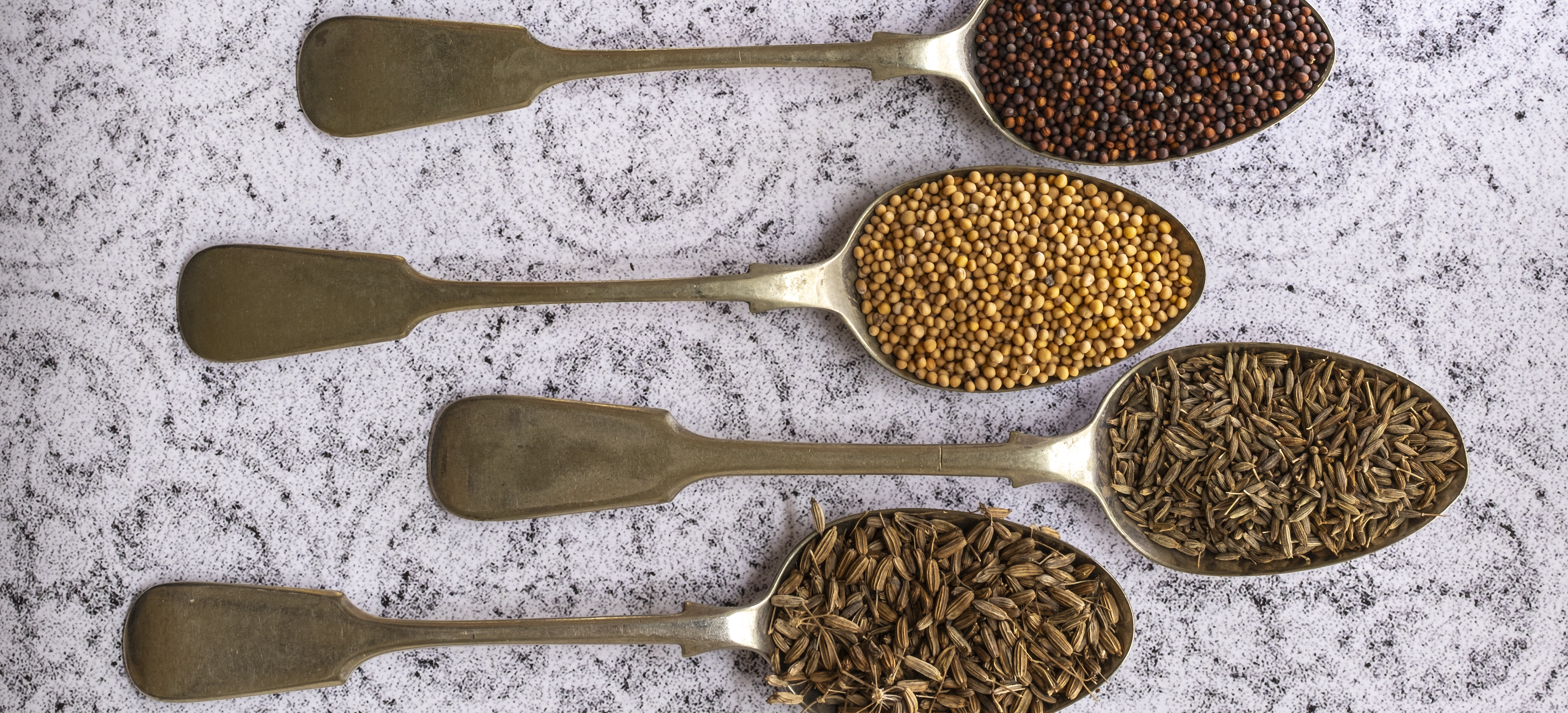Pear and Eggplant Kasundi
- Pickles, Chutney, Relish & Sauces
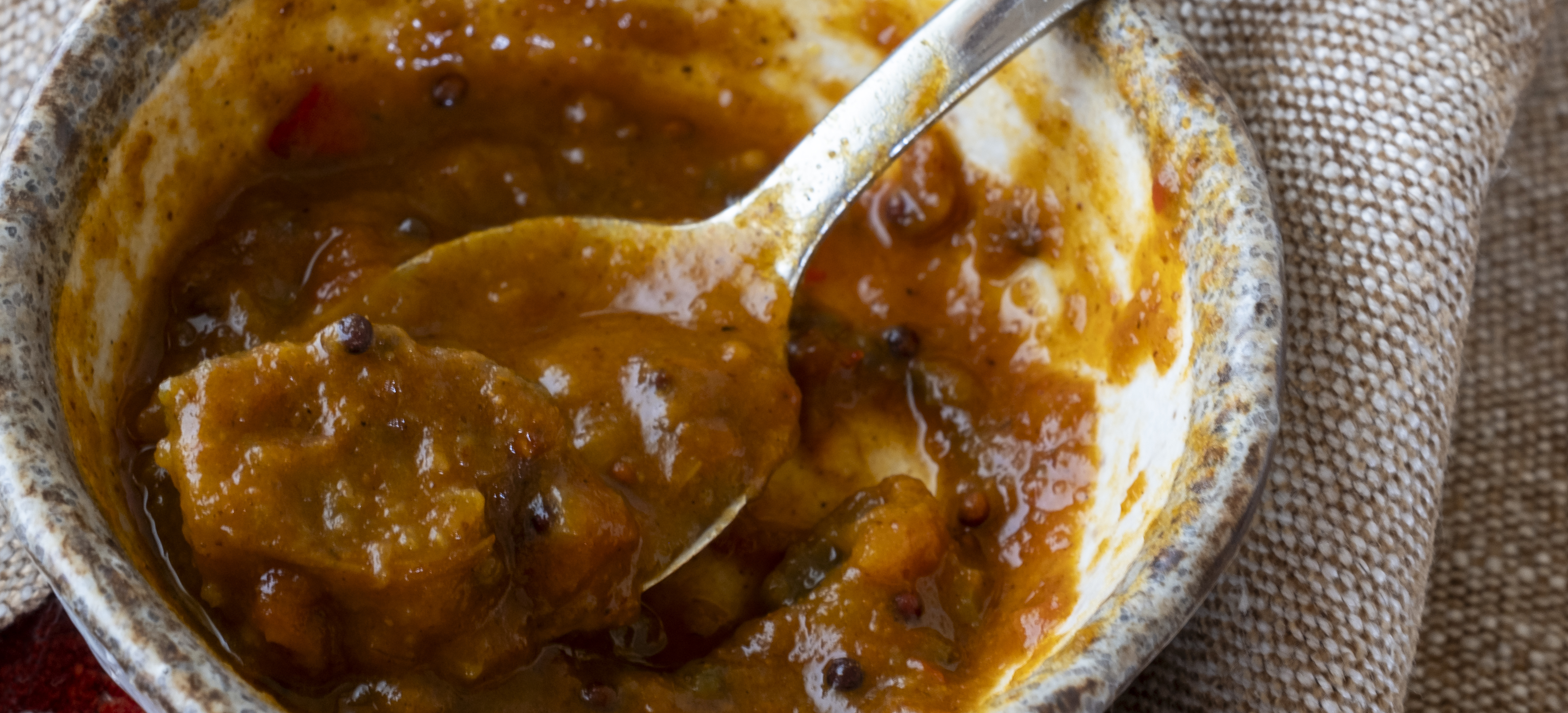
Kasundi has to be one of my all-time chutney favourites. In this recipe, pear, eggplant, tomatoes are combined with a load of aromatic spices to produce a truly sensational Indian style chutney. This is must for your chutney recipe collection and it’s a unique culinary gift for those who the chase full bodied flavours and zing. It’s sweet and savoury and the combination of spices creates the unique kasundi-style flavour. You can adjust the chilli heat load to suit your style. Rejoice in the mystic aroma’s that seduces all who enter the kitchen while its cooking.
- Preparation Time:
- 40 minutes
- Cooking Time:
- 2.5 hours
- Quantity:
- 10 x 375 ml jars
PREPARATION
Have hot sterilised glass jars and lids with a protective lining ready
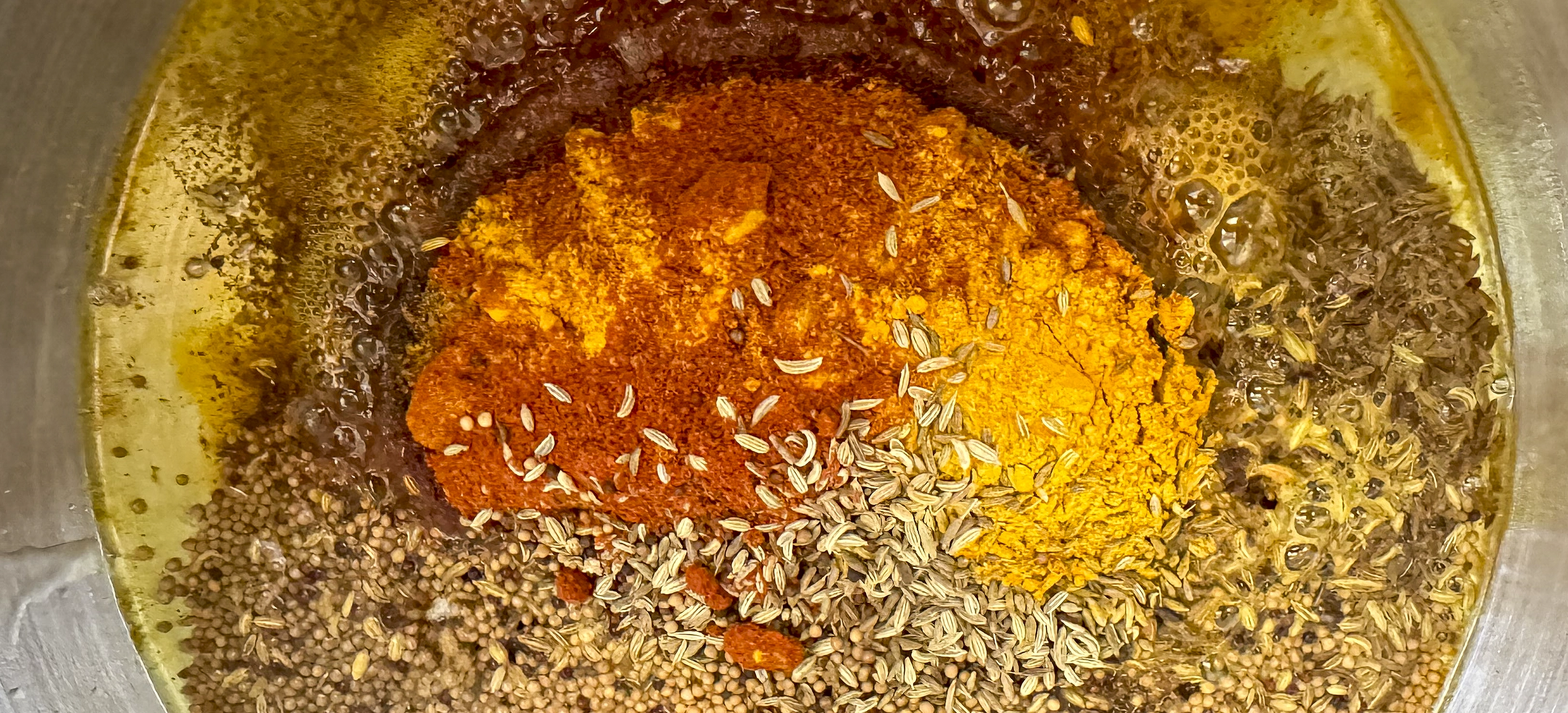
INGREDIENTS
- 100 ml
- Peanut oil
- 2 tablespoons
- Yellow mustard seeds
- 2 tablespoons
- Black mustard seeds
- 2 tablespoons
- Turmeric powder
- 2 tablespoons
- Chilli powder
- 3 teaspoons
- Cumin seeds
- 3 teaspoons
- Fennel seeds
- 1 1/2 teaspoons,
- Garam masala
- 2 medium
- Garlic bulbs, peeled
- 5
- Red chillies, dried
- 3 tablespoons
- Ginger, ground
- 300 ml
- White wine vinegar
- 1.6 kg
- Tomatoes, ripe
- 3 medium
- Eggplant
- 4 medium
- Pears, cooking
- 300 ml
- White wine vinegar
- 140g
- Sugar, raw
- 1 tablespoon
- Salt, cooking
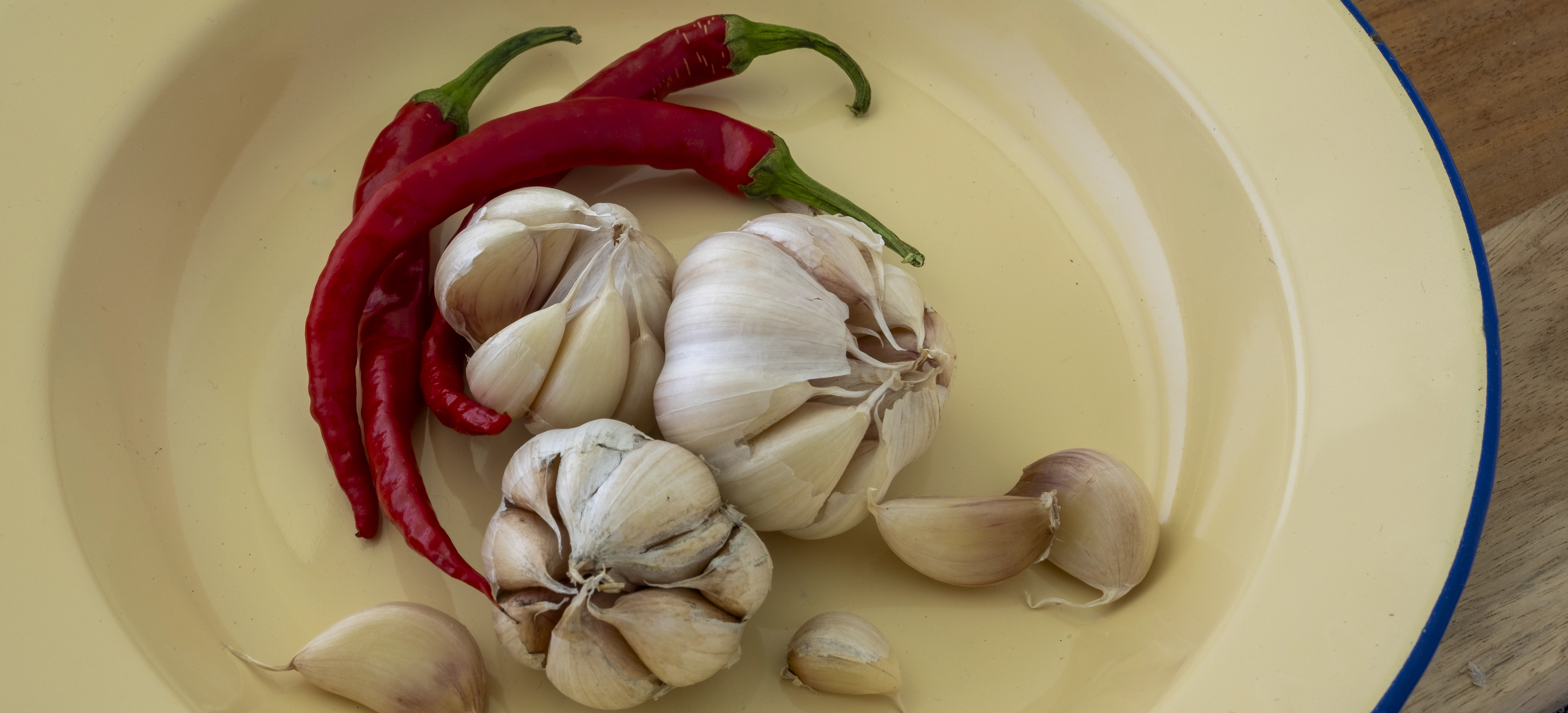
METHOD
Wash and gently dry the tomatoes to remove any shop or garden dust and debris.
To remove the tomato skin. First cut around the stem area by inserting a small sharp vegetable knife then using as slight inward angle cut in a circular motion all the way around the stem. Quickly blanch in boiling water, remove with a large-slotted spoon and place immediately into cold water. Remove the skins and discard. Coarsely chop the tomatoes and put aside.
Wash and dry the eggplants and pears. Chop the eggplant into small chucks and put aside. The pears should be prepared just prior to adding the final mix together to cook as this will prevent them from discolouring.
In a stainless-steel preserving pan or heavy bottom stainless steel pot heat the peanut oil and gently cook the yellow and black mustard seeds, stirring continuously, until they pop. Add remaining spices, turmeric, chilli powder, cumin, and fennel seeds and garam masala.
Fry gently over medium heat until the mixture is fragrant. Remove from the heat and put aside.
Next place the following ingredients into a blender or food processor; peeled garlic bulbs, chillies, ground ginger and the 5 tablespoons of white wine vinegar to blend to a smooth paste. Add this paste to the fried spice mix and fry together for 2-3 minutes.
Add the chopped tomatoes, eggplant, any remaining white wine vinegar, raw sugar and salt. Now is the time to peel, core and coarsely chop the pear and add it immediately to the pot.
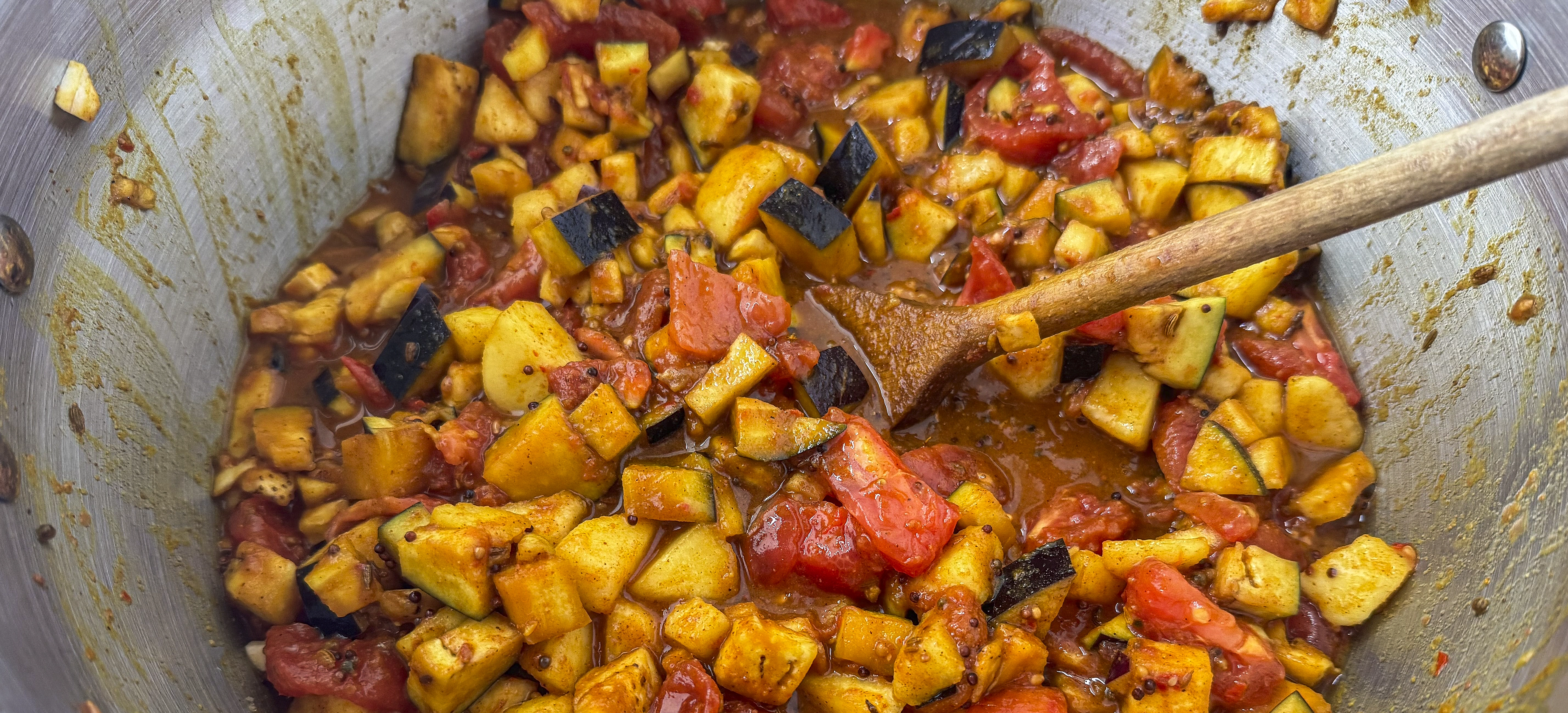 Return to the heat, bring gently to the boil, then reduce the heat to a gentle simmer and cook for approximately 1 hour with the lid on, or until the eggplant and pears are beginning to soften.
Return to the heat, bring gently to the boil, then reduce the heat to a gentle simmer and cook for approximately 1 hour with the lid on, or until the eggplant and pears are beginning to soften.Remove the lid and continue to cook, and simmer over gentle heat for approximately 1 hour, until the kasundi has thickened to a thick sauce and the pear, eggplant and tomatoes have completely broken down.
Stir occasionally, particularly as the mixture thickens, to prevent the kasundi from burning on the bottom of the pan.
Use a funnel to pour into hot dry sterilised screw cap sealable bottles, fill to approximately 2.5cm (1 inch) from the top of the jar and seal with hot dry lids.
Allow to cool and wipe the jars down to remove any spills during the bottling stage.
-
Label and store in a cool dark place in the kitchen or pantry.
Allow to mature for at least 4 weeks before eating.
NOTES
- Choose clean ripe fruit. Do not use overripe and never use mouldy fruit as this will produce a poor-quality chutney.
- If you want a chunkier chutney texture, cut the fruit into larger pieces. If there are several types of fruit, cut them to the same size.
- Any neutral flavoured vegetable oil (e.g. rice bran, canola oil) can be used as a substitute for the peanut oil.
- The number of spices and garlic sounds extraordinary, but it works. The combination generates all the flavour associated with a kasundi.
- The degree of chilli heat of the kasundi depends upon the amount of and type of chilli powder and dried chillies used. These recipe amounts can be adjusted to suit your taste.
- Handling chillies
- It is important to wash your hands thoroughly after handling and de-seeding chillies. Chilli oil is easily transferred from the chillies to hands. If you touch your eyes or any delicate areas, the chilli oil will be transferred on contact and create a burning sensation.
- Salt quality
- Use good quality pickling salt when making pickles and preserves. Many commercial salt brands contain stabilisers and anti-caking agents and often iodide which forms a whitish haze and sediment. These additives, in particular iodine, can affect the appearance and taste of pickles and preserves during the maturation and storage period.
- The ingestion of a cocktail of anti-caking chemicals such as calcium silicate, sodium silicoaluminate, tricalcium phosphate, magnesium carbonate, silicon dioxide and yellow prussate of soda, is also unnecessary.
- Read the label before buying and look for salt that is free from any artificial additives. My favourite salt is Olsson Cooking Salt. No commercial benefit is received from Olsson Salt.
- Cooking times are an approximation only. They are provided as a guideline as cooking times are influenced by the type of pot and its diameter and height, speed of cooking and fruit ripeness, size, and moisture level. Cooking time will depend upon:
- The size of preserving pan - the broader the pan the quicker the evaporation
- Degree of fruit ripeness – the riper the fruit, the sweeter and juicier the initial kasundi will be
- The degree of heat when cooking – the higher the heat, the greater the boil which will produce greater evaporation:
- Kasundi consistency
- To test the kasundi is cooked to the right consistency, spoon a little of the mixture on to a plate. It should hold its shape.
- Good quality jars should be used in all preserving, particularly when they are processed in a hot water bath. Thin jars often cannot withstand the temperatures and may crack either in the bath or on and or after removal. Avoid the disappointment and invest in some good jars from a homewares or preserves outlet. Select jars that have non-reactive lids as the vinegar solution can cause the lids to rust over time.
- Knowing your Spices
- Chilli
- Why is chilli so hot? The legendary heat comes from a natural compound, capsaicin, which develops and is concentrated in the white pith with some migrating to the seeds. The amount of capsaicin a chilli contains depends upon the chilli variety and growing condition. High temperatures and drought can increase capsaicin production as the chilli ripens. To control and reduce the amount of heat, use the most appropriate variety and amount of chilli, remove as much or little of the white membrane and seeds and vary the length of contact time with other ingredients while cooking to suit your taste.
- Chilli heat or pungency is measured in Scoville Heat Units (SHU) which was developed in 1912. The higher the Scoville rating the hotter the chilli. The ubiquitous Jalapeno varies between 2,500 – 10,000 SHU which is mild compared to the Habanero and Scotch Bonnets 80,000 – 150,000 SHU or the hottest chilli in the world, the Carolina Reaper, which has been measured at 2million SHU! Aptly named the Reaper; use with extreme caution.
- Dried chilli develops an earthy, woody, and nutty flavor complexity that is rare among other herbs and spices. Substitute dried chilli in recipes throughout the year, make your own special chilli powder blend with dried ground cumin, garlic and oregano or grind finely to make a hot chilli powder.
- Fennel (Foeniculum vulgare)
- A hardy and herbaceous plant, its seeds are collected form the flowers which are threshed, cleaned, and dried. The seeds vary in colour from sage green to yellow brown. It has a mild aniseed flavour and is used in sweet and savory foods.
- Native to the Mediterranean, its cultivated throughout Europe, Türkiye, Japan, Argentina, North America, and California.
- Ginger (Zingiber officinale)
- Ginger has a hot-spice, citrusy woody taste. It’s available as a fresh underground stem, a rhizome, as a finely ground powder and preserved in sugar. The dried and preserved version is used in baking, dried is also used in spice blends whereas fresh ginger is used widely in Asian cuisine.
- Do not substitute dried ginger for fresh when specified in a recipe as the dried form has a stronger and more aromatic flavour.
- When purchasing fresh ginger, avoid older rhizomes with signs of shrivelling as the plant is drying out and the flesh can be fibrous.
- Cumin (Cuminum cyminum)
- Seeds are harvested from annual plants the seeds are collected form the small, white, or pink-mauve flowers. The plants are cut down four months after planting then dried and threshed to separate the fruit, which is then dried further. The seeds are approximately 6mm long (1/4 inch) and will keep their flavour if stored in a sealed container in a cool, dark place.
- Cumin powder is also available however it loses its flavour and aroma quickly and should be used within a couple of months.
- It has a pungent, earthy herby and woody flavour that is distinctive and highly aromatic.
- Thought to be native to the Nile Valley and Eastern Mediterranean, it's cultivated in India, China, Syria, Türkiye, and Iran.
- Ginger (Zingiber officinale)
- Ginger has a hot-spice, citrusy woody taste. It’s available as a fresh underground stem, a rhizome, as a finely ground powder and preserved in sugar. The dried and preserved version is used in baking, dried is also used in spice blends whereas fresh ginger is used widely in Asian cuisine.
- Do not substitute dried ginger for fresh, when specified in a recipe, as the dried form has a stronger and more aromatic flavour.
- When purchasing fresh ginger, avoid older rhizomes with signs of shrivelling as the plan is drying out and the flesh can be fibrous.
- Garam Masala
- Garam masala is not an individual spice. It’s a traditional Indian blend of spices and serves as the linchpin in a range of different Indian dishes – notably curry. Regions and many households will develop their own specialty blends.
- The foundation spices are cumin, turmeric, chilli, ginger, and garlic. To this often cassia, clove, cardamon, Indian bay and/or fennel, enjoyed for their warmth and fragrance are added in different quantities.
- The spices are ground together to a fine powder and then sieved to remove the husks and fibers.
- Mustard Seeds (Brassica alba – white/yellow), (B. juncea - brown), (B. nigra - black)
- Green mustard seeds are harvested when full-sized but before they are ripe, so they don’t split open. They are dried, and graded before being further processed for oil, powder or to remain as seeds.
- White mustard seeds are light brown rather than white and are often also called yellow or light brown mustard seed. They have a mild taste.
- The brown and black seeds are smaller, and the brown are hotter and often used in Indian cuisine. The black seeds are less common and have a distinctive aroma. Brown mustard seeds can be readily substituted for the black. Mustard has a pungent, earthy, and sharp flavour.
- Turmeric (Curcuma longa)
- Turmeric is a leafy tropical plant of the ginger family. The fresh leaves are used as a herb or to wrap foods in, however the rhizome (root) used either fresh or dried as a powder is more widely known.
- It has a woody, floral, bitter flavour and works particularly well in complex blends where its pungent flavour acts as a foundation which binds the other flavours together. It’s often used to colour relish mixtures with an intense yellow colour.
- If too much is used by itself, its bitter notes can be overwhelming.
